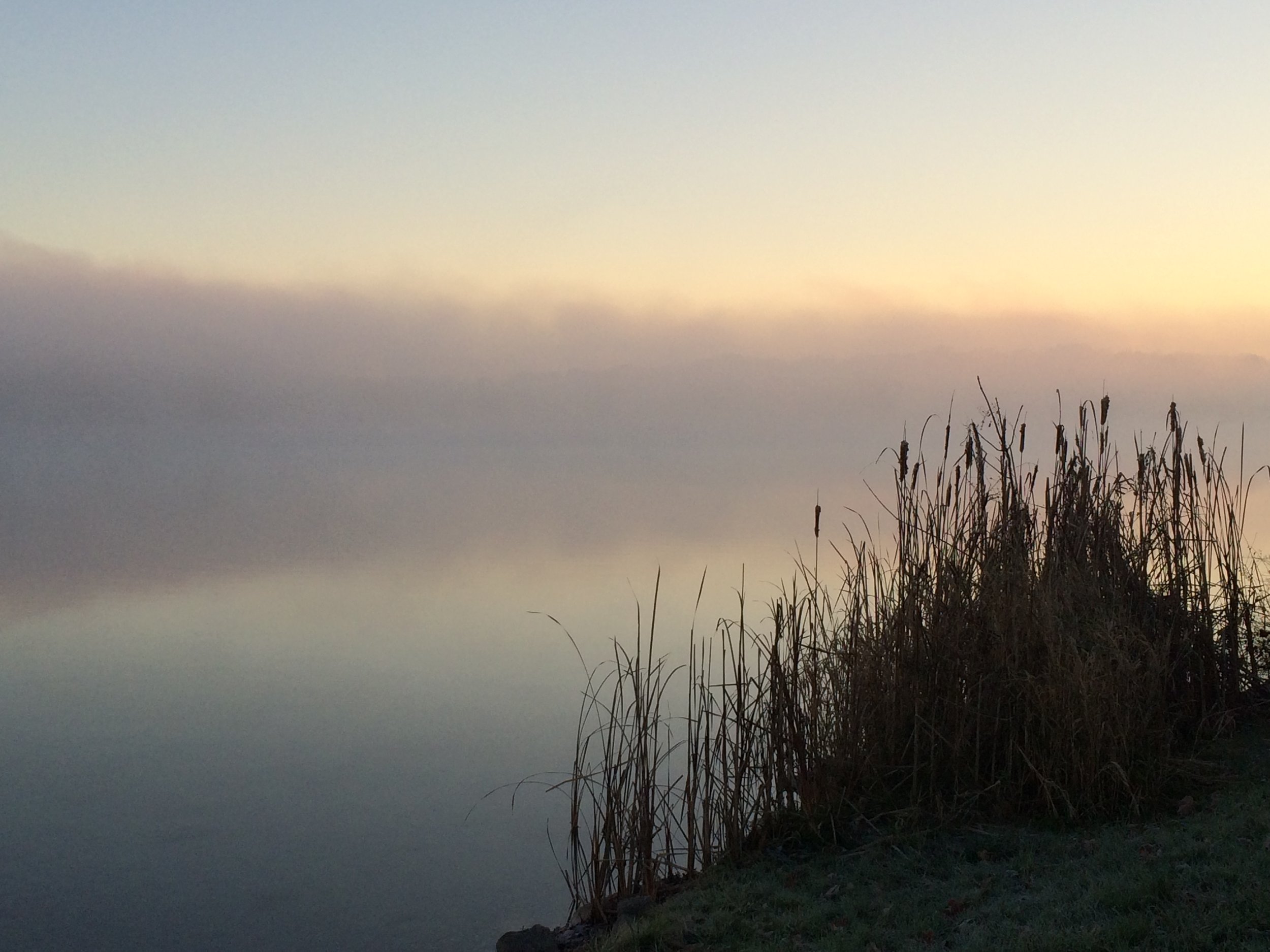
About Diamond Lake
“It’s a beautiful lake with clean water!”
- S. N.
Diamond Lake is located in southwest lower Michigan, in nearly the center of Cass County. It is situated southeast of the village, and county seat, Cassopolis. Four different townships intersect in its waters; Calvin, Jefferson, LaGrange, and Penn. The lake is 1,078 acres in size, 60% of the lake is less than 10 feet deep, and is 64 feet at its deepest. Most of its shoreline is lined with over 900 homes and cottages, including an occupied island of about 43 acres in the center of the lake, accessible to island residents by the privately owned barge/ferry during the summer months. There is one marina on its shores, and one public boat launch.
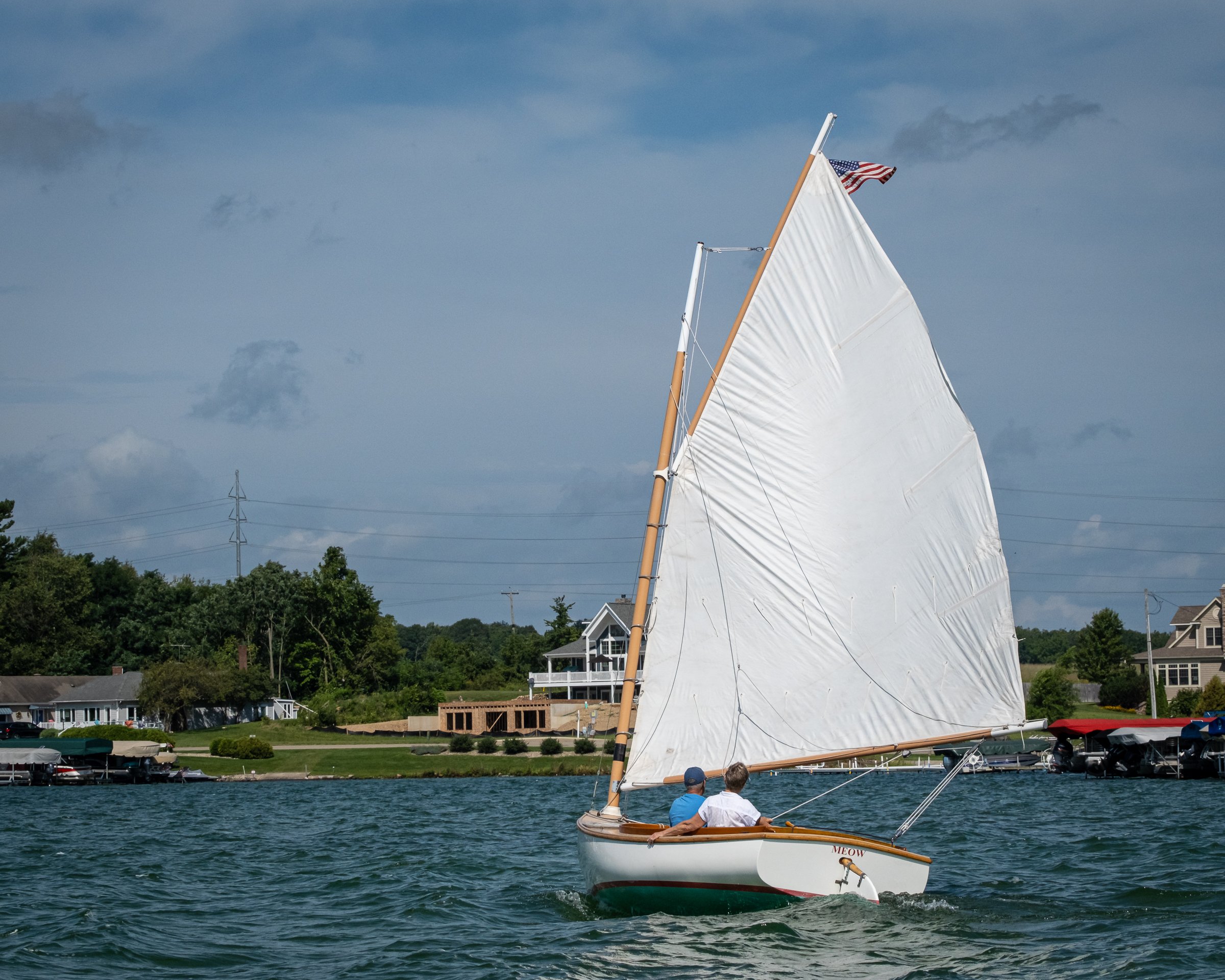
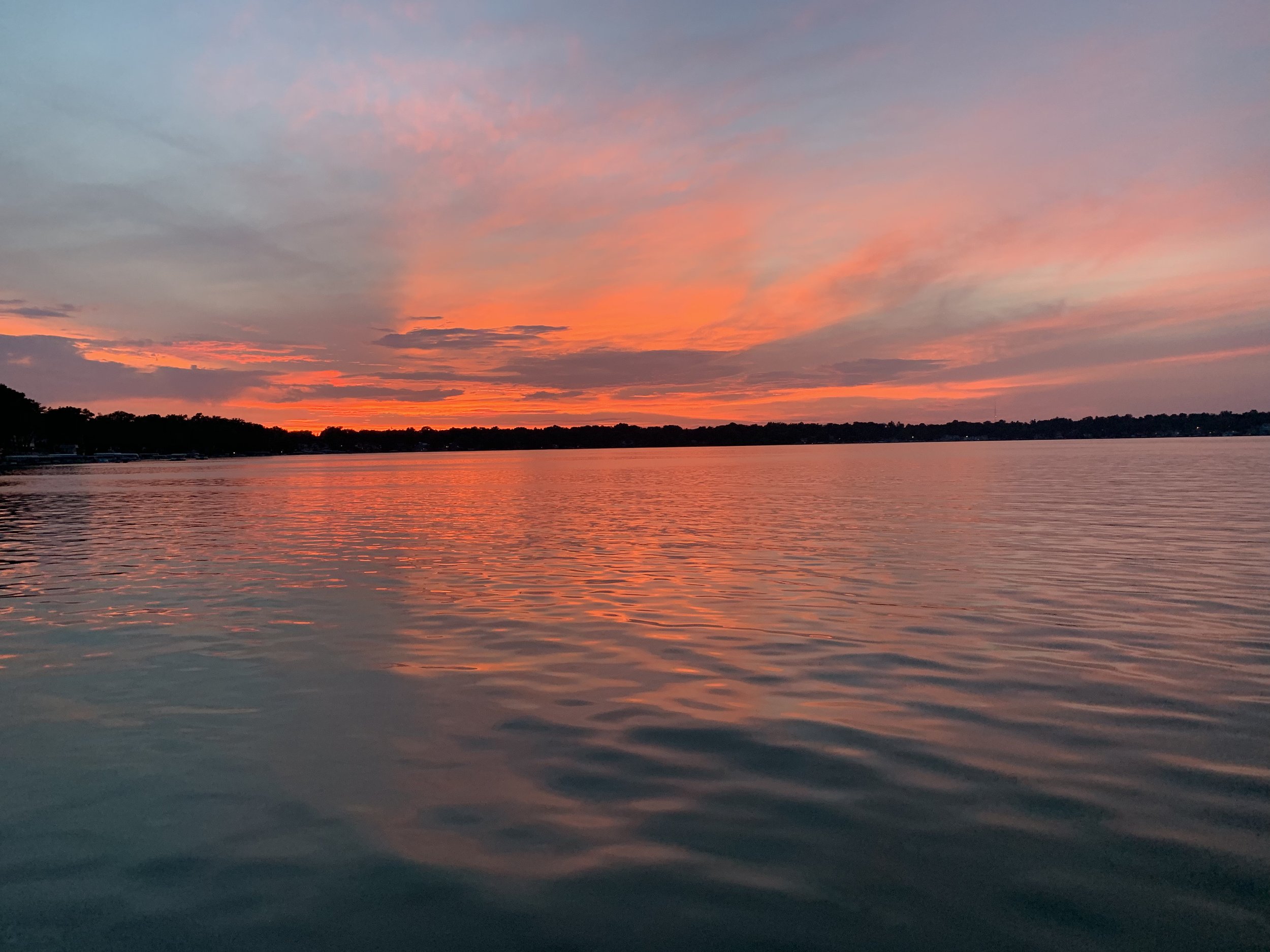
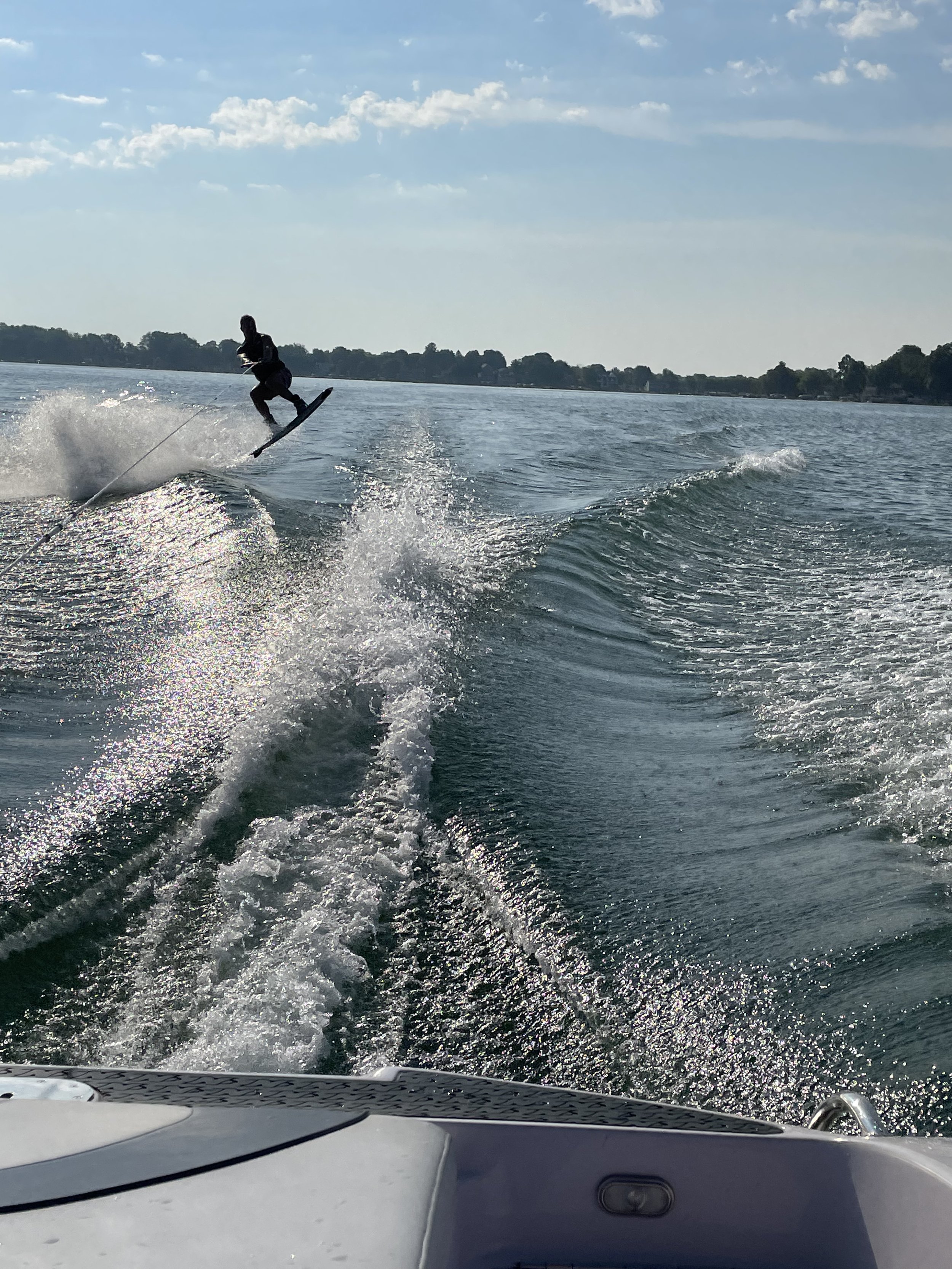
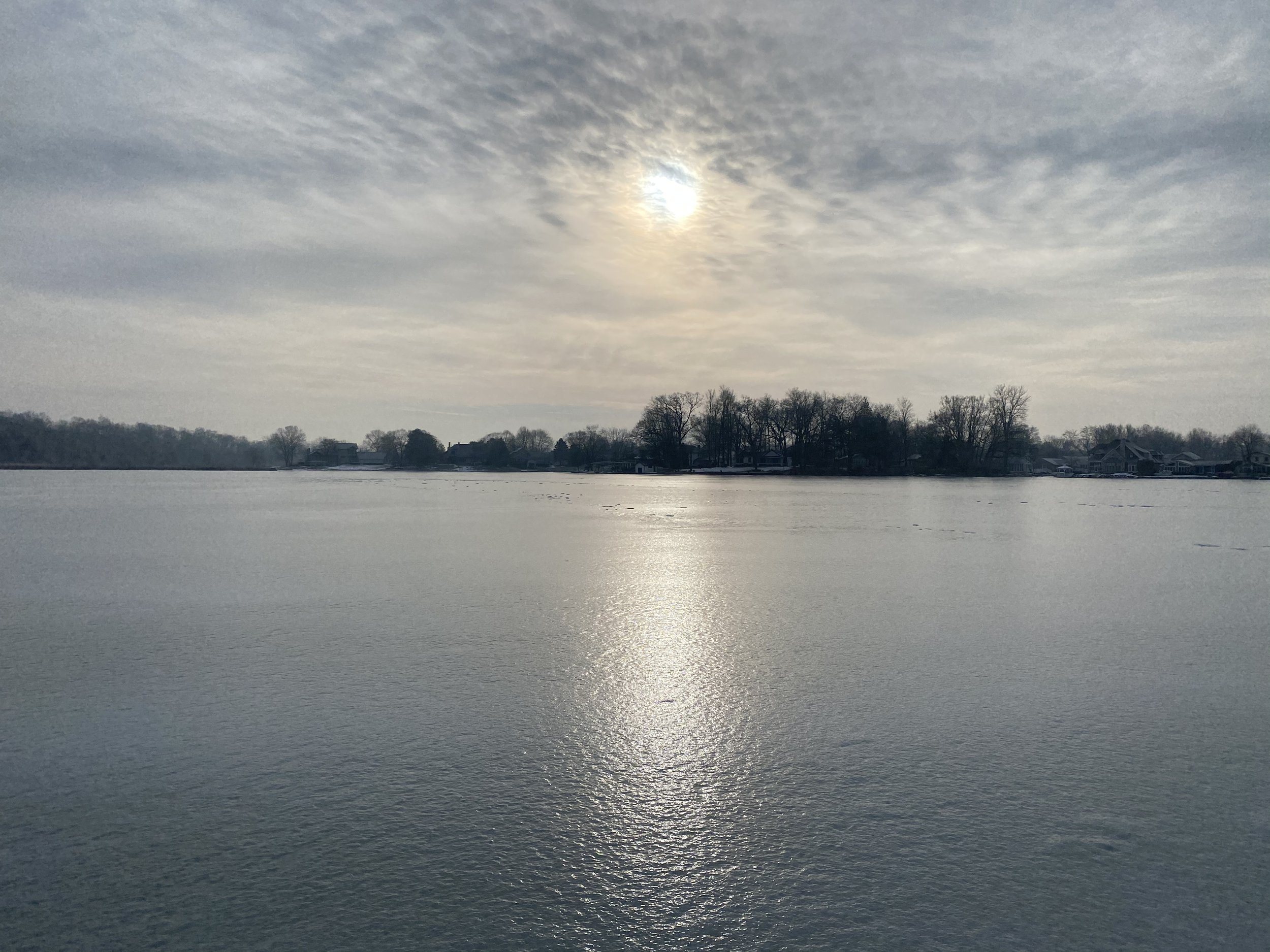
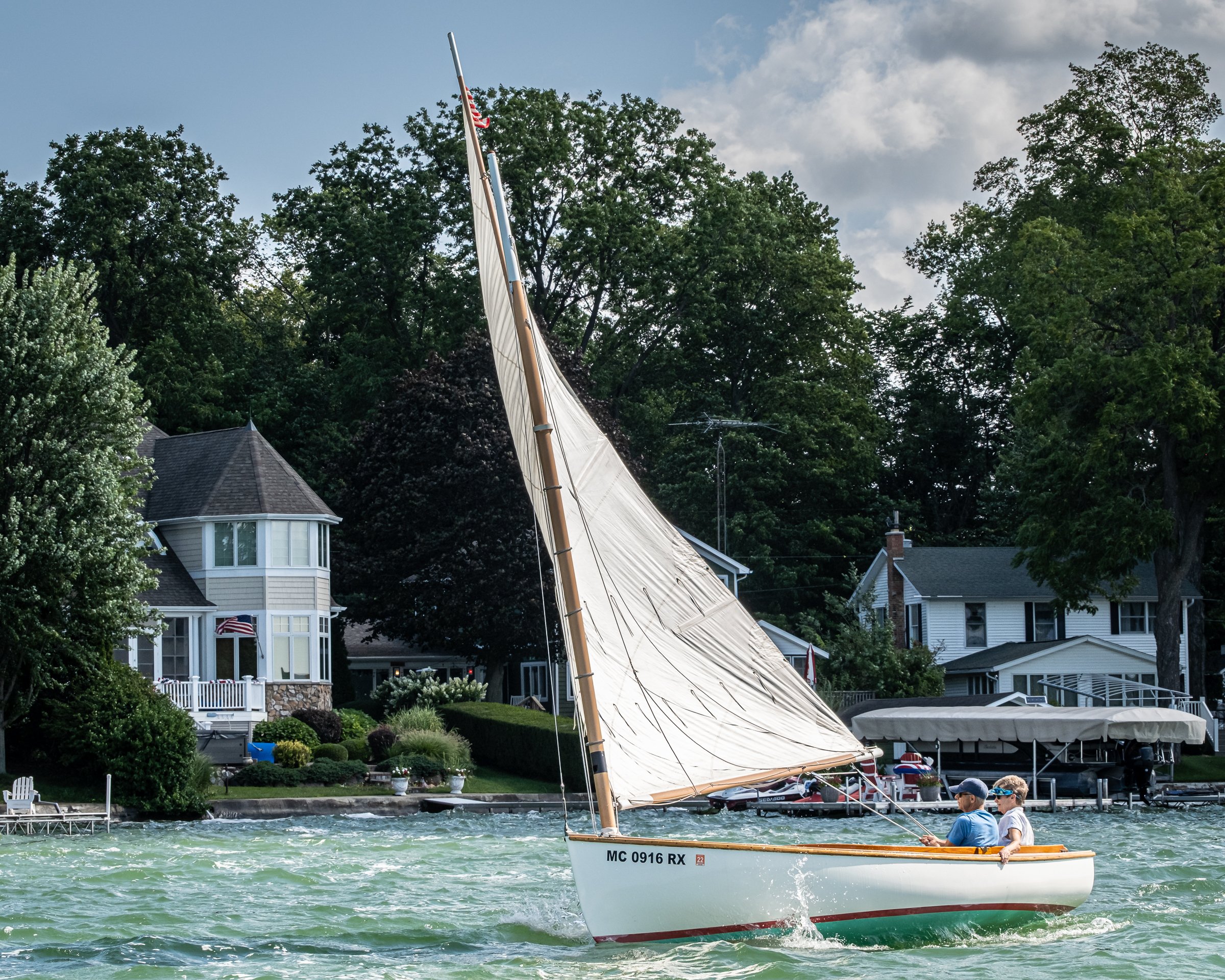





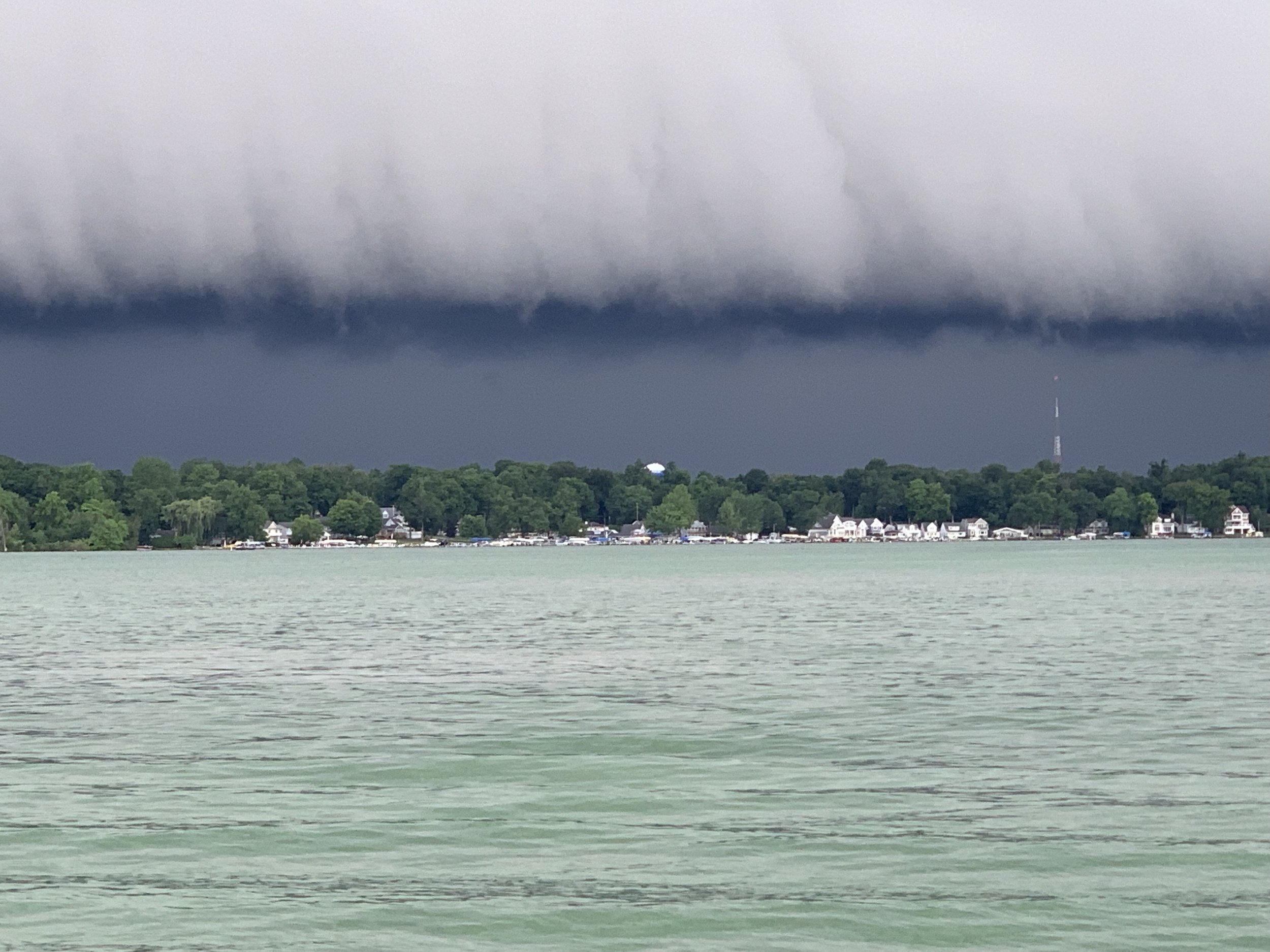
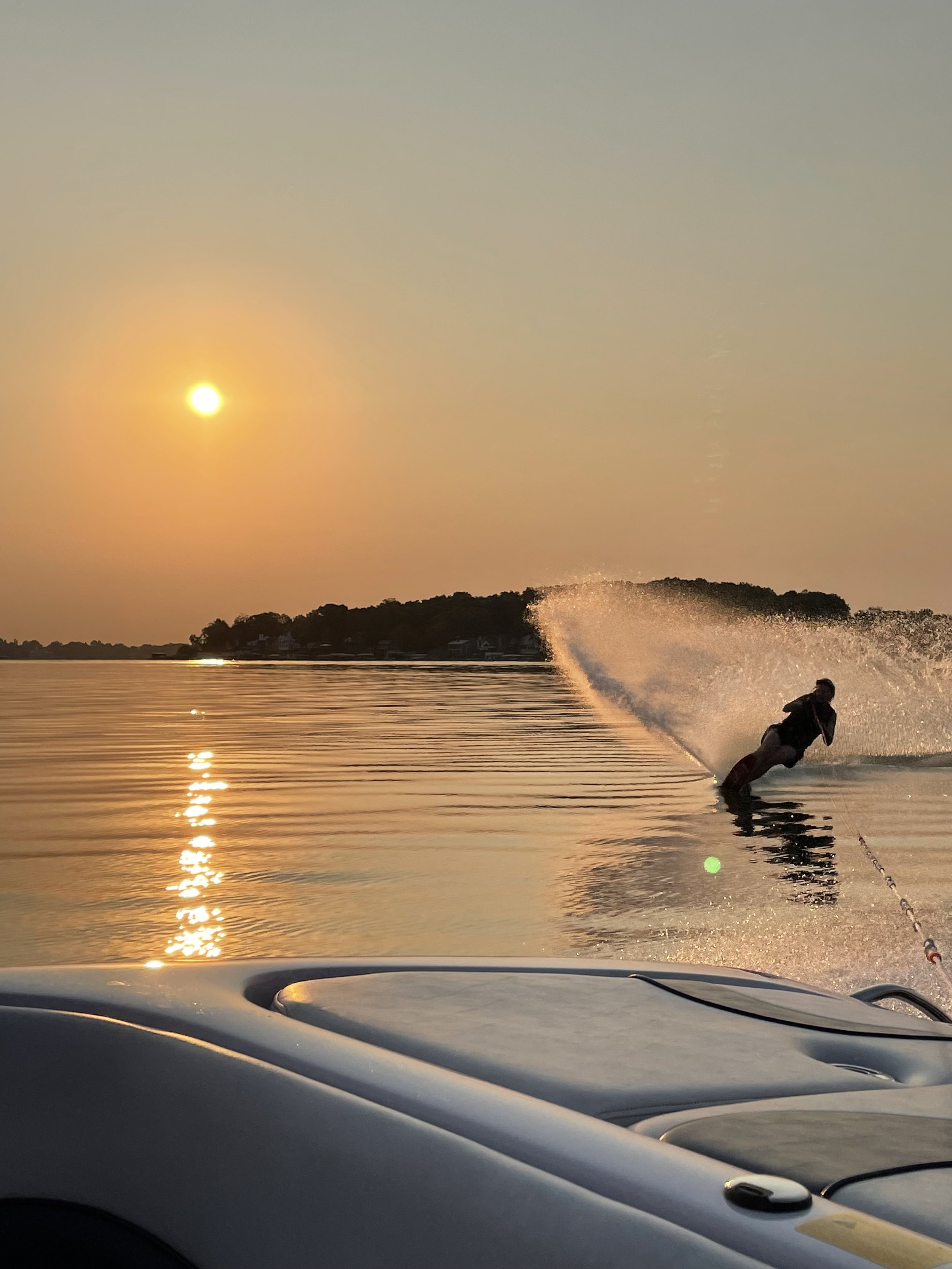
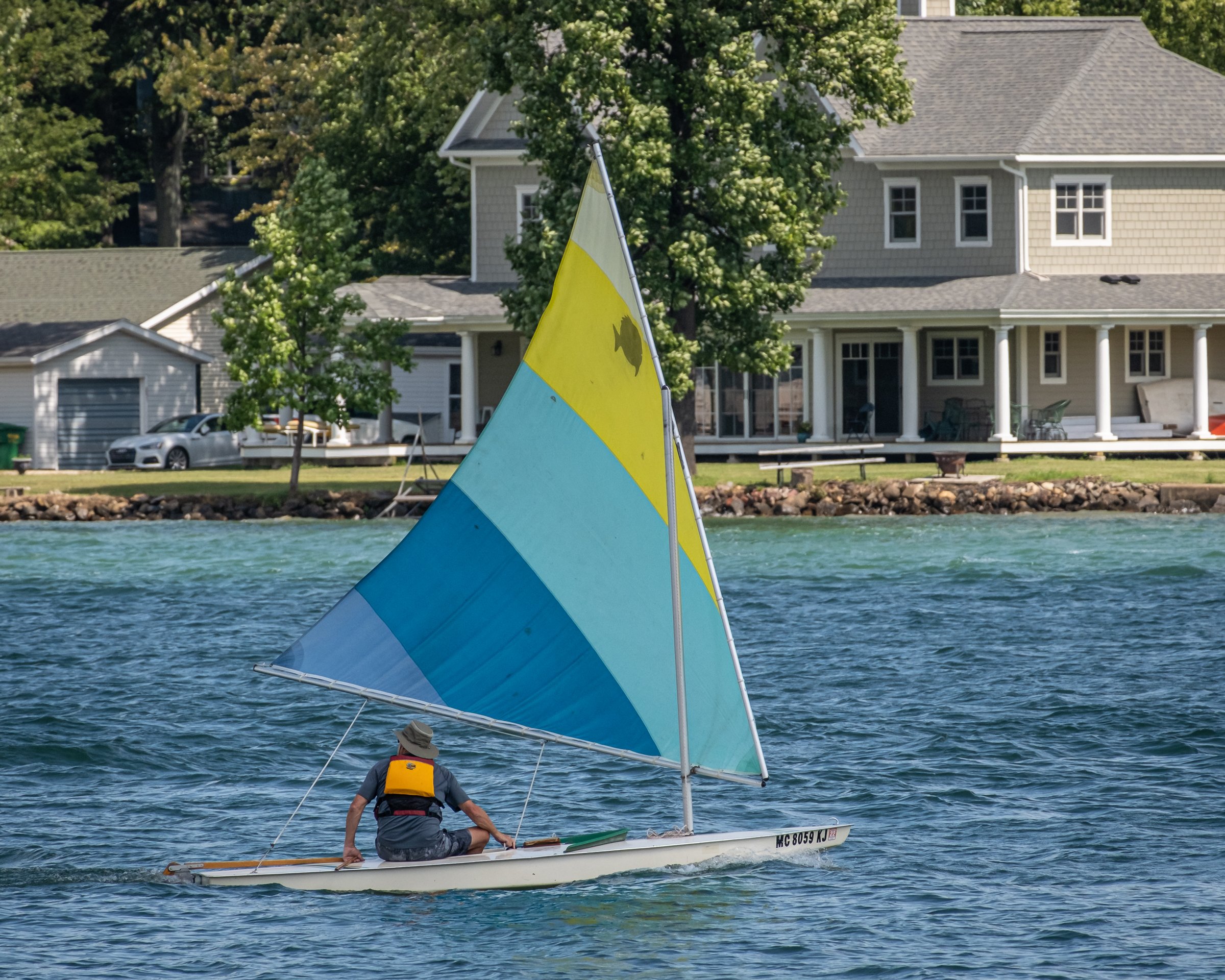


View & Download “Diamond Lake: A Resource and Guidebook for Residents”
View Lake & watershed facts, info about water health, how you can help protect the Lake, and more.
Diamond Lake History
-
1618
Etienne Brule discovered Michigan while trying to find a northwest passage.
1668
Father Jacques Marquette organized the first white settlement in Michigan at Sault Ste. Marie.
1679
French explorer LaSalle explored the St. Joseph river to South Bend.
1751
Fort Ponchartrain (later named Detroit) was built to protect the French fur trade with the Indians.
1783
Michigan formally passed into the hands of the Americans at the end of the Revolutionary War.
1787
Michigan became part of the newly organized Northwest Territory. Constant Indian attacks prohibited white settlement.
1805
Michigan was organized as a territory. Less than a dozen small white settlements were in all of Michigan.
1813
General Lewis Cass was appointed Governor over the Territory of Michigan.
1814
The British gave up the last of their outlying posts in Michigan. Hunter and trapper Zaccheus Wooden began trapping fur on the shores of Diamond Lake and returned to his home in the East after the trapping season.
1818
Michigan public lands were opened to settlers. Governor Cass encouraged settlement by improved relations with the Indians.
1821
The Chicago Treaty with the Indians stipulated that the U.S. had the privilege of making and using a road through Indian country from Detroit to Chicago. The Chicago Road (South Trail) followed the winding path used for centuries by the Indians. The Potawatomies ceded away all of the land in southwestern Michigan east of the St. Joseph River in this treaty. Three thousand Indians were present at the conference.
1825
The Erie Canal opened and made way for settlers to come to Michigan from the East. Uzziel Putnam became the first permanent white settler in the Cass County area. Putnam founded the settlement of Pokagon Prairie.
1828
Many Potawatomi Indians were still living in the area during the early period of settlement. Some of the Indian leaders during this period are; Topinabee—a true friend of the white man, Weesaw—a large man, over 6 feet tall, who had 3 wives and was often seen in the white settlements, Shavehead—an ill tempered, sullen and insolent man who had a lock of flowing hair down his back, Pokagon—a converted Roman Catholic. Indians who lived around Diamond Lake cut large trees and hollowed them out to make fishing canoes used to catch whitefish and enormous pike. At some time Indians apparently built an underwater stepping-stone trail from Geneva Shores to the north point of the island.
1829
Job Wright, the recluse with two thumbs on one hand, isolated himself on the island in Diamond Lake due to his dislike for humanity. He may have been the most unusual man ever to walk the shores of Diamond Lake. He always wore buckskin breeches and a fringed shirt secured at the waist with a leather belt from which he suspended a sheath for his long hunting knife. He built a log cabin on the island where he lived until his death in 1842. His grave marker can be found in Prospect Hill cemetery. A village post office was set up in Mr. Silvers “Old Red Store.”
1830
Cass County was organized and named after Governor Cass. The town of Geneva was platted on the north shore of Diamond Lake and intended to be the county seat. Oxen drawn carts brought supplies from Detroit for the first general store in the new community.
1831
The Village of Cassapolis was platted. Cassapolis was chosen over Geneva as the county seat after a long and bitter controversy. The first double log cabin was constructed and opened as a hotel. A road commission was formed to build corduroy roads in the county.
1832
The settlers had concern for their safety when news of the Blackhawk Indian war reached them. They made plans to fortify themselves on Diamond Island, but the war ends before it reached Cass County. Work on the Chicago Road was interrupted by the war.
1833
The first jail was built in the Village of Cassapolis (The old lock can be seen in the Log Cabin Museum).
1834
Chicago Road was completed and passed just north of Diamond Lake. (This road is now called M-60).
1835
The first Cass County courthouse was built in the Village of Cassapolis. Stage Coach service began on Chicago Road.
1837
Michigan became a state.
1838
Most of the Potawatomi Indians are removed to Kansas. Only Leopold Pokagon’s tribe were allowed to remain in a village about a mile west of the St. Joseph River and just north of the Indiana state line.
1842
The Underground Railroad was established to provide secret shelter for slaves fleeing the South. These safe havens were called stations and the men living at the stations were called conductors. Covered wagons were hitched and ready to go at a moments notice. There were two stations in Cass County kept by Stephen Bogue.
1843
The Ritter General Store opened in the Village of Cassapolis (The store once stood on Broadway where the Village Floral Shop is now located and was moved across from the Post Office where it still stands.) The first schoolhouse was built out of logs.
1844
Hunters and trappers of this time carved the date and their names on a giant Beech tree on Diamond Island. (This tree is still standing on the island.)
1845
The Cass County Advocate rolled off the presses as the first newspaper published in Cassapolis. Its politics were Democratic.
1847
Enraged Kentuckians sent raiding parties into Cass County to try to recover runaway slaves who were being hidden at the farms of Quakers while on their way to Canada.
1848
Black bears were numerous around the Village of Cassopolis and more than 20 were shot.
1850
The National Democrat newspaper, successor to the Cass County Advocate, was published and announced the change in spelling of Cassapolis to Cassopolis.
1863
The Village of Cassopolis was incorporated. The census reports that there were 475 persons residing in the village.
-
1870
The Airline Railroad tracks were laid linking Chicago with Cassopolis. It soon became the property of the Michigan Central. The Grand Trunk Railroad linking South Bend with Cassopolis was laid about the same time. Fishing without regulations comes to a halt on Diamond Lake as fishing season was closed from September through May and spearing was outlawed.
1871
Passenger and freight service began on the Michigan Central and Grand Trunk Railroads. The area was no longer land-locked and began to flourish.
1872
Three officials of the Michigan Central Railroad purchased a tract of land on the north side of Diamond Lake and built a large house referred to as “The Chicago House” which they intend to share as a vacation home. The grand three-story building with a wrap-around porch sat on top of a knoll overlooking the lake. The Michigan Central Depot was a short distance from the home. There are few roads leading to the water, unless one wishes to trespass over a farmer’s field to get there. The only connecting link between Cassopolis and the lake was the rude road that once led to the Village of Geneva on the north shore. There were a few well-trod paths from the outskirts of town that in time were used by horse and carriages. An article in the Cassopolis Vigilant described Diamond Lake as, “a beautiful sheet of water, a resort for pleasure seekers with boats for fishing,” and, “large parts of the island were taken up with tent…from the main shore it looked like a besieging army had made an encampment on the island.”
1873
The first State Fish Hatchery was established at the Crystal Springs Campground in Pokagon Township. (This is the oldest Methodist camp meeting ground in Michigan.) The South Bend Union proclaimed Diamond Lake as, “A noted pleasure resort with bountiful preparations for guests made by Mr. Moon. Picnic parties to rusticate to hearts content on the island for a reasonably established fee at Moon’s Landing. The railroads offer excursion rates.” It was apparent that the recreational advantages of Diamond Lake are becoming commercial, with fishing and picnicking being the primary interests. Guests came by way of the railroads with easy access to the lake from two depots.
1874
Steam launches began service on Diamond Lake. The Cassopolis Vigilant reported, “The steam yacht ‘O.W. Powers’ bid the land goodbye forever yesterday and now walks on the waters of Diamond Lake like a thing of life.”
1878
Fred Moon and Colonel Allen of Kalamazoo made a croquet court, a roller skating rink, an outdoor dance platform and an amphitheater on the island. Forms of illumination are added so festivities could be enjoyed after dark. Refreshment stands, bathhouses and picnic areas were increased and improved. Charles Morton purchased an interest in the lake business of Moon & Linsley and the leasing of the “Chicago House” with all of its facilities; the bowling alley, dance floor, steamer boats and docks of what we know as Forest Hall went public and the competition between it and the island’s activities became evident. South Bend’s Singer Sewing Machine Company held the largest outing of the season on the island with 1600 people in attendance.
1879
The Cassopolis Vigilant reported, “There are now sufficient buildings on Diamond Lake Island to shelter 5000 people from storms.” The Cassopolis School celebrated its first high school graduating class of two students.
1880
The name of the “Chicago House” (also called “The Club House”) was permanently changed to “Forest Hall,” and was leased as a public resort with all of its facilities by the firm of Moon, Linsley & Morton. It has a bowling alley, dance floor at the water’s edge, steamer, boats and docks. The Island boasted of having been brilliantly illuminated by an electric light. The light was in the vicinity of the amphitheater and was augmented by lanterns and torches. A large rowing regatta was held on Diamond Lake between clubs from all over the U.S. and Canada. A gang of roughs who set fire to a tent at Forest Hall and to the steamer Gauntlet evidently to create excitement while they ransacked the rooms of guests marred the event.
1881
The first 4th of July fireworks display was held on the lake. All businesses in Cassopolis closed at noon and the village was almost deserted, nearly everyone went to Diamond Lake. Two steamboats were operating on the lake; the O.W. Powers was 65 feet long and was capable of carrying 350 people, the Gauntlet was 55 feet long and carried about 75 passengers. Steamer rides cost 20 cents for a round trip. Forest Hall and the Island shared equally in attracting visitors and offering fine opportunities for recreation.
1882
The Island celebrated the 4th with enthusiasm by shooting off fireworks and artillery, with contests, a minstrel show, the Cassopolis band and releasing 15-foot balloons.
1883
Almeda Moon and her son Fred Moon formed the Joliet Club on Diamond Lake Island. Members of the club built a 300 foot building on the west bank of the Island situated 100 feet from the water. The resort had doors and porches that resembled early motels. Passage was provided to and from the Island by one of the two steamers operating on the lake.
1885
American inventor F.W. Olfeldt produces the first pleasure motorboat in the United States. It has a two horsepower motor was powered by naphtha, which turned out to be a dangerous fuel.
1887
Tent camping began at Kamp Kozy. A single lane carriage path brought campers past the Smith farmhouse to the waters edge. Kamp Kozy was the first beach on the lake named and where Farmer Smith brought his cattle to water them every morning and evening. Businessmen from the village, camping with their families, left early in the morning in their carriages to go to work. The pier at Kamp Kozy was known as Smith’s Landing.
1889
Captain John Bartlett purchases Diamond Lake Island and takes over operation of the Diamond Lake Island Hotel.
1890
Captain Charles Shillaber, a retired English sea captain purchased land and built the Blink Bonnie Hotel. It was a two story building with about 20 rooms for guests, a large dining room and a nice porch on the west side. Elick Lowitz and wife Nellie are first time guests at Forest Hall. Fish stocking became a regular practice in Diamond Lake.
1891
Diamond Lake Park (Park Shore) was platted and Diamond Lake Hotel (later called Anchorage Inn) was built. Mr. Rudd and Dr. Laughton purchased Forest Hall and turn it into a Health Resort. Mr. Rudd was a Clerk of Cass County and Dr. Laughton was a homeopath physician. Dr. Laughton was of extremely small stature with snow-white hair and used an ear trumpet.
1892
Ida and William Rettic build the cottage “Idlewile” on land purchased from Captain Shillaber.
1893
Diamond Lake became a favorite vacation spot for many Mishawaka residents although travel to Diamond Lake from Mishawaka by horse and buggy took most of a day.
1894
Fred G. Eberhart, the Vice President of Ball Band in Mishawaka built the third cottage on Diamond Lake called “The Beeches.”
1895
Diamond Lake Park was renamed Park Shore. The Hutchings family purchased the Diamond Lake Hotel and the boat landing at Park Shore. The Hutchings provided lodging, meals, bait and supplies for fishermen. One of the first telephones in the area was installed at Hutchings Landing. Cyrus Funk, a Cassopolis dentist built the “gingerbread” cottage with the tin roof on the south end of Park Shore. The Blink Bonnie Resort built a 30-foot tall toboggan slide. Water was pumped by hand to the top to provide a wet run for the sleds. James Leach purchased an 80-acre farm on the north side of the lake from James G. Hayden for $75 an acre and started the Shore Acres Hotel. J.C. Eberhart launched the first naphtha-powered boat on the lake.
1896
Capt. Shillaber called a meeting at Sandy Beach to bring all yacht sailors together to form a Diamond Lake Yacht Club. The sailing yachts, “Marguerite,” “Priscilla,” and “Katy Van” were launched from a railway at Sandy Beach. Competitive sailing began on Diamond Lake. The water level was so low that the sand bars at Eagle Point and Willow Point are above the waterline.
1897
J.M. Studebaker built a 22-room summer home at Sandy Beach adjacent to the Blink Bonnie Hotel. The summer home called “Crescent Surf” was built in just two weeks at a cost of $1500. The steamer Cassopoliscarried the Cassopolis band in the first 4th of July boat parade, and over 1000 people watched the fireworks display from the shore and some from boats. Mr. Ellett Hopkins built a double deck steamboat The South Bend on the shore of Diamond Lake and began service in competition with the other steam launches.
1899
Capt. Shillaber became Diamond Lake’s first sailing instructor when he began giving sailing instructions aboard his beautiful sailing yacht, “Marguerite.” (One of his young pupils, John McKinlay, later became President of Marshal Fields & Co.) The Blink Bonnie Dance Pavilion was moved to a more prominent place on the beach. The dances were a highlight of the summer. Mr. and Mrs. Elick Lowitz of Chicago built an eight-room cottage in Park Shore at the corner of Park and Maple streets. An insulated under water telephone cable was laid to the island. Several other telephones were already in use at the lake. Ice deliveries were made from the Stone Lake Icehouse by calling #109. A telephone alarm was called into Cassopolis when a cottage in Park Shore caught fire and burnt down. EE Drake installed 12 arc lamps to light up Park Shore.
-
1900
An 1863 Civil War cannon was dragged through the mud and placed on the hill at Eagle Point. (The cannon is still on the hill in the lawn of the Walter’s cottage.) There are no roads to the cottages on Eagle Point, rowboats or steamboats provide the only access. J.M. Studebaker set the first timed speed record in an automobile from South Bend to Diamond Lake, one hour and twenty minutes. A street leading to Park Shore from Cassopolis was constructed and paid for by subscription, two or three gates had to be opened and closed to get to the lake via this street. There were five resort hotels competing for the growing resort business; Forest Hall, Blink Bonnie Hotel, Diamond Lake Island Hotel, Shore Acres Hotel and Diamond Lake Hotel.
1902
Eagle Point Road was made, allowing access into Eagle Point from Brownsville Road. Captain Bartlett purchased the steamer CASSOPOLIS to go along with his other two steamers Glenn and South Bend, allowing him to corner the passenger steamboat business.
1904
Dr. Cyrus Funk launched a new 18 ft. steel boat powered by a two horsepower gasoline engine.
1905
The Blink Bonnie Hotel was sold, and closed a short time later. The grounds are platted as Sandy Beach. Electricity was brought into Sandy Beach under the influence of J. M. Studebaker. Windmills were replaced by electric power. An electric light line was extended from Cassopolis to light Park Shore Road all the way to the lake.
1906
Ben Birdsell built the cottage “Somerset” in Sandy Beach. Wood salvaged from a livery stable was used to build “Hain Villa,” a fourteen-room resort hotel in Park Shore. Mrs. Hain employed a staff of 24 to maintain her lakeside resort.
1907
Jacob Woolverton purchased the Birdsell cottage “Somerset.” (This beautiful old cottage in Sandy Beach is still in the Woolverton family and has been preserved in close to its original condition and decor by Hugh and Betty Lou Woolverton.)
1908
J. M. Studebaker bought the Blink Bonnie Hotel and then sold half of the building to Walter Bogue for $225 and the other half to James Leach. Mr. Bogue moved his half to his farm on the north side of M-60 and refurbished it for his family home. Mr. Leach moved his half to Shore Acres where it was incorporated into an expansion of his Shore Acres Hotel.
1909
The Carnegie Library was built on the west side of Broadway St. in Cassopolis. (This building is currently the Cass County Historical Library.)
1910
American inventor Ole Evinrude produced the first portable outboard motor, a two horsepower gasoline powered model.
1911
The Diamond Lake Park Improvement Association was formed with a board of directors and seventy-seven members. The purpose of the Association was the improvement of conditions about the lake and the protection of fish. Two houses were razed in the process of improving Park Shore Rd. and made a direct route from Cassopolis to Park Shore. The Association built a long wide pier for the use of its members.
1912
The first Labor Day celebration was held on the lake with water sports and various contests. Suitable prizes were awarded. “Turk” McDermott, the World Champion Long Distance swimmer swam two complete rounds from Park Shore to the other end of the lake without stopping using his famous frog kick and the Australian Crawl. Kamp Kozy was platted and lots were offered for sale.
1913
A road to Kamp Kozy was opened past the Smith’s red brick farmhouse at the curve in the road, and the first two cottages are built in Kamp Kozy. The hymn “The Old Rugged Cross” was completed and sung for the first time at a revival meeting in the nearby Village of Pokagon. The double-deck steamer South Bend caught fire and burned to the waterline off the north shore of the island.
1915
A regulation baseball field was built in Park Shore and named Yost Park. The “Cassopolis” team was good and did very well against semi-pro and local independent teams. Dissatisfied with the 18 mph speed of his father’s boat, J.M. Studebaker Jr. launched a hydroplane, one of the first “fast” boats on the lake. Shore Acres Hotel completed large additions and added a dance hall.
1918
The Association built a dance hall near the “Association Pier” in Park Shore. The dance hall was a unique nearly round structure with outside benches on all but the side facing the lake, where people could sit during intermissions or kneel and watch the dancers inside. Dances were held on Thursday and Saturday nights for Association member families, and not open to the public or maintained for profit.
1919
Spring Beach was platted. The Shore received its name from the many natural springs found along the shoreline. The Diamond Island Hotel was closed.
1921
A nine-hole golf course was constructed on the grounds of the Forest Hall Resort Hotel. Two holes of the Diamond Lake Golf Course were on the north side of the seldom-traveled gravel road (M-60).
1922
Ralph Samuelson invented water skiing at Lake City, Minnesota. A cable was laid for a barge between Shore Acres and the Island, but the distance was apparently too great and too treacherous because the project was abandoned.
1923
The Pioneer Society of Cassopolis built The Log Cabin Museum on Stone Lake. Exhibits were moved from the Court House to the new museum. The Lowitz family purchase the Gar Wood designed and built racing hydroplane “Miss Chicago” and launch her on Diamond Lake, this caused quite a stir among the local populace, as hundreds of people come to Park Shore where she was docked.
1924
Diamond Lake’s Leigh Wade was pilot of one of three U.S. Army Air Service planes to complete the first around the world flight.
1925,p>E.J. Kloss purchases the Island and it was platted for sale as residential lots. Howell Point was platted. Construction of a bridge to the southeast side of the Island was started and many large pilings are driven before lake residents band together to halt the project.1926
Diamond Shores was platted. Forest Hall closes operations as a resort hotel but remained in use as the clubhouse for the Diamond Lake Golf Club. The Vigilant absorbs The National Democrat leaving just one weekly newspaper in Cassopolis.
1927
A dam was constructed by the Diamond Lake Association at the outlet of Diamond Lake that fixed the lake level at 852.25 feet above sea level.
1928
Park Shore was platted. E. L. Lowitz built the nine-hole Park Shore Golf Course with the help of farm hands. The Club House had showers, which was quite a luxury.
1930
The Howell Estates Development Co. was formed to develop the 80-acre tract at Howell Point.
1931
The large pilings remaining from the aborted bridge project, an eyesore for several years, were removed. They had been sticking up out of the water 10 to 15 feet.
1933
“Hain Villa,” one of the last two resort hotels closed. Ed Yost purchased the property and converted it into four apartments.
1934
The derelict hull of the old steamboat South Bend, left on the northeast side of the Island where it sat for many years, was towed out to deep water and blown up with dynamite.
1935
The Forest Hall Resort Hotel was torn down and wood from the building was used to construct a new clubhouse for the Diamond Lake Golf Club. A round of golf cost 25 cents.
1938
The new Diamond Lake Yacht Club was formed at a meeting on the front lawn of Joe Geary’s summer home with 48 members. Horace Fox was elected as the first Commodore with the objective of promoting sailboat racing and good fellowship among its membership. The Anchorage Inn, which was formerly the Diamond Lake Hotel in Park Shore mysteriously exploded and burns just before the 4th of July. Children lit their firecrackers from the smoldering embers. A severe storm suddenly struck during a Sunday DLYC race capsizing all 18 sailboats and causing some masts to break. Fortunately no one was seriously injured.
1943
The Bidwell family purchased the old Hutchings Landing site in Park Shore and built a new store which they operate in conjunction with a dock, boat rental and picnic area. The Michigan Central railroad tracks were abandoned and the rails are taken up to provide steel for the war effort.
1945
N.L. LaMunion purchases the marshy southeast side of the Island and has two canals dug. The digs from the canals are used to fill the marshy areas. He purchases 10 Army barracks and has them ferried to the Island to be sold as summer cottages. Four rooms are detached from the Studebaker cottage and moved to the Island on two barges pulled by a single powerboat. (Wood was scarce after WWII).
1946
The ferryboat Diamond Island Queen operated between Eagle Point and the Island. It took six minutes to cross the 1100 feet of open water and was guided by a cable. The first marina on the lake was opened in Shore Acres and was called Clapper’s Marine Hospital. Wade’s Addition was platted.
1947
The Diamond Lake Yacht Club opened its first clubhouse in the former Clappers Marine Hospital sales office after remodeling and refurbishment. Cassopolis’s Edward Lowe developed his cat litter box filler product called “Kitty Litter.”
1948
Geneva Shores was platted and named after the lost village of Geneva. Clapper’s Marine Hospital was sold to “Cap” Purdy and the name was changed to Purdy Marine Company. Thorpe Marina was opened on the south side of the Island with gas pumps, dock space, boat hoist, warehouse and picnic area.
1950
Diamond Cove was platted. Diamond Lake had the largest registered Snipe fleet in the world with 45 sailboats. The DLYC Nipper fleet was introduced with nine sailboats.
-
1951
The barge to the island ceased to operate after the death of Mr. Kloss who owned most of the island and operated the barge. Diamond Island Association was formed.
1953
N.L. LaMunion purchases the remaining undeveloped portions of the Island and the barge was reactivated on the south side of the Island connecting the Island with Carleton Drive.
1954
The Barko family purchased the Park Shore Golf Course.
1958
A biological survey was made of Diamond Lake. One finding of the survey was that Diamond Lake was not suitable for trout because the cool water strata is deficient of oxygen during the summer season. The first aluminum pontoon boat designed by Godfrey Marine was launched on the lake. There are 262 waterfront cottages on the mainland and 24 on the Island. (Old-time Island residents dispute this number as being too low.) There are also 69 boathouses at the waters edge. Most roads to the lake are unimproved with only M-60 and Eagle Point Road paved.
1959
An attempt was made to build a road to the Island. The Diamond Lake Yacht Club and other Lake Organizations combined their legal talent and financial aid to stop the project. Walt Bieneman worked on a Bill prohibiting bridges and causeways to be built across lakes less than 1500 acres in area, which was passed by the Michigan Legislature.
1960
The Studebaker Corp. used the Diamond Island barge in their ads introducing the new Lark model automobile. Click here for picture of this ad.
1962
The old Shore Acres Hotel was renovated with a modern contemporary addition and opened as the Diamond Harbor Inn Restaurant and Gift Shop. Dave and Danny Herman purchased the Bidwell store and grounds in Park Shore and open the Park Shore Marina. Jack Mell completed a three-year scientific study of bass fishing in Diamond Lake, and the findings of this study were published in Outdoor Life Magazine.
1963
The marina in Shore Acres, called the Purdy Marine Company, was sold to the Newall family and the name was changed to Diamond Lake Marina.
1965
The Lowitz and Hepler families began sponsoring the 4th of July fireworks displays shot from the point in Shore Acres.
1967
Some of the Diamond Island residents formed The Diamond Island Lake Corporation and purchased the remaining undeveloped portion of the Island from N.L. LaMunion in order to preserve it in its natural state.
1968
The dam was relocated to a new site just west of Eagle Point Road as part of a plan by developer Karl Jones to dredge the marsh and wildlife areas on the south side of the lake. The Jones plan to create a 46 home site Sail Bay area followed by a Yacht Bay area with over 400 home sites became a very controversial issue and was met with stiff opposition. The dredging and platting of Sail Bay was completed. The Gem Theater was razed in Cassopolis. It had been a landmark for 127 years; used first as the courthouse and then as a movie theater for the previous 40 years. Thorpe’s Marina on the Island ceased operations.
1969
Steve Palatinus and John Landaw purchase the Park Shore Marina. The first Hobie Cat catamaran was launched on Diamond Lake. The grave of Job Wright, the first white inhabitant of the Island, is located in Prospect Hill Cemetery by Dr. Ray Spenner and a marker was placed at the site.
1970
A Diamond Sparkles, a 232 page hardbound edition of Diamond Lake history written by Lois Webster Welch, was published. The Diamond Lake Yacht Club built a new clubhouse on Shore Acres Road next to the Diamond Harbor Inn. The Cass County Health Department in cooperation with the Diamond Lake Yacht Club conducted a pollution survey and control program for Diamond Lake.
1972
The first sewer plans are developed.
1973
Dr. Fred Matthews and Earl Marhanka bought Diamond Harbor Inn from Mr. Charles Zeman.
1974
Twenty-five condominium units were built in the Colony Bay area on the southeast side of the lake.
1975
Wayne Meagher launched “Diamond Belle,” an 18-foot steam powered boat complete with a steam calliope. The boat was an instant hit with residents who enjoyed seeing and hearing the boat make its almost daily trips around the lake in the summer.
1976
Scuba divers Zoltan and Diane Tiser and some friends discover the wreck of the old steamboat South Bendoff the northeast point of the Island.
1977
A Grumman “Widgeon” amphibian plane makes a hard landing on Diamond Lake damaging the fuselage. The plane began taking on water making it too heavy to lift off again. After several attempts to bail water and take off, the plane sank in over 50 feet of water near the island. The pilot was rescued, and a team of divers using flotation devices later salvaged the plane. The Lowitz and Hepler families end their sponsorship of the 4th of July fireworks display and Louie Beehler took over with financial support from Diamond Lake residents.
1985
The new Diamond Lake Association was formed. The Edward Lowe Foundation was created to provide education, information, research, and assistance to small businesses.
1989
Divers Jim Couch, Dave Yates, Bill Archer and Zoltan Tiser do an underwater reconstruction of the steamboat South Bend. The old 60-foot boat was a favorite dive site. A buoy marker with the words “Ship Wreck” was placed near the bow section that is about 40 feet below the surface.
1990
One half of the old Blink Bonnie Hotel was moved from the former Walter Bogue farm on M-60 to the Big Rock Valley Farm complex on the east side of Decatur Rd. and was restored.
1992
The Diamond Lake sewer system was completed.
1993
The Diamond Lake Newspaper On and Around the Water was established for the purpose of better lake communication and to preserve and develop the history of Diamond Lake. Zebra Mussels were found for the first time in Diamond Lake.
1994
Diamond Lake property owners got a welcome tax reduction with the enactment of Michigan’s new property tax law.
1995
The Diamond Lake Association took over responsibility for the 4th of July fireworks celebration under Doug Horstmann.
1996
A survey of watercraft on Diamond Lake showed that there were; 430 powerboats, 224 jet skis, 213 pontoon/deck boats, 165 rowboats with motors, 148 pedal boats 70 rowboats without motors, 74 Sunfish sailboats, 53 M Class sailboats, 41 Hobie Cat sailboats, 31 Butterfly sailboats, 63 other type sailboats, 48 canoes, 11 windsurfers, 7 rowing shells, 5 kayaks, 1 steamboat, and 1 barge.
1998
The Diamond Lake Yacht Club celebrated its 60th anniversary with an Art Show, a Vintage Boat Show and a Lake Home Tour.
1999
The Council on Aging opened their new facility, The Edward Lowe Center, on Decatur Road. The Diamond Lake Marina closed operations on Shore Acres Rd. leaving Park Shore Marina as the only waterfront marina.
Louis and Donna Csokasy, founded the Diamond Lake Orchard off of Eagle Point Road, fulfilling Mr. Csokasy’s dream of having his own apple orchard.
2000
The barge transfers the first modular home to the Island. The Village of Cassopolis attempts to annex Park Shore and Howell Point. The Diamond Lake Association purchases Fireworks Island on behalf of the lake residents. The uninhabitable remaining part of the Diamond Island Hotel was torn down.
2007
Diamond Lake Orchard expands to include cherry trees, and plans on adding peaches.
Historical information was compiled by Jean Schultz, using local resources including the book A Diamond Sparkles by Lois Webster Welch


